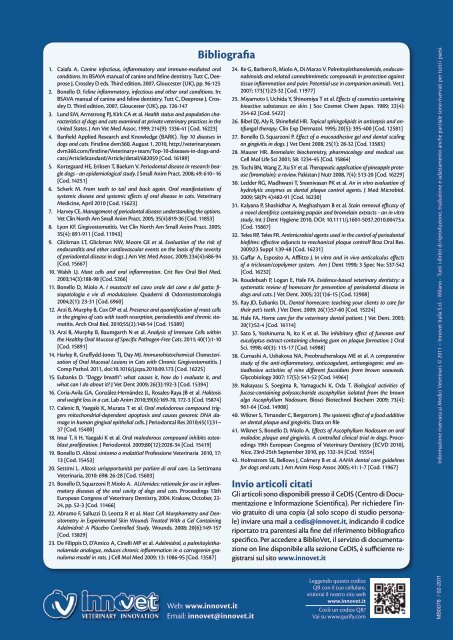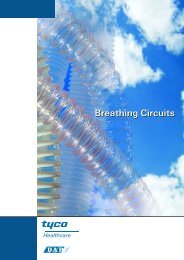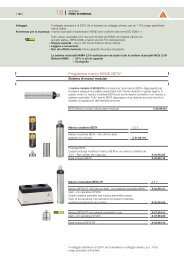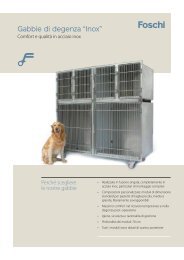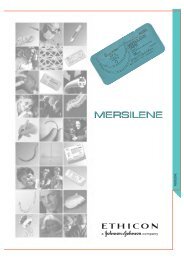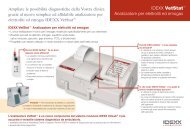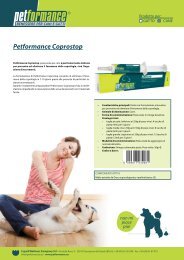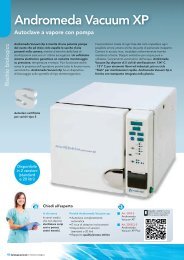You also want an ePaper? Increase the reach of your titles
YUMPU automatically turns print PDFs into web optimized ePapers that Google loves.
1. Caiafa A. Canine infectious, inflammatory and immune-mediated oralcond<strong>it</strong>ions. In: BSAVA manual of canine and feline dentistry. Tutt C, DeeproseJ, Crossley D eds. Third ed<strong>it</strong>ion, 2007, Gloucester (UK), pp. 96-1252. Bonello D. Feline inflammatory, infectious and other oral cond<strong>it</strong>ions. In:BSAVA manual of canine and feline dentistry. Tutt C, Deeprose J, CrossleyD. Third ed<strong>it</strong>ion, 2007, Gloucester (UK), pp. 126-1473. Lund EM, Armstrong PJ, Kirk CA et al. Health status and population characteristicsof dogs and cats examined at private veterinary practices in theUn<strong>it</strong>ed States. J Am Vet Med Assoc. 1999; 214(9): 1336-41 [Cod. 16223]4. Banfield Applied Research and Knowledge (BARK). Top 10 diseases indogs and cats. Firstline dvm360, August 1, 2010, http://veterinaryteam.dvm360.com/firstline/Veterinary+team/Top-10-diseases-in-dogs-andcats/ArticleStandard/Article/detail/682059[Cod. 16189]5. Kortegaard HE, Eriksen T, Baelum V. Periodontal disease in research beagledogs - an epidemiological study. J Small Anim Pract. 2008; 49: 610–16[Cod. 14251]6. Scherk M. From teeth to tail and back again. Oral manifestations ofsystemic disease and systemic effects of oral disease in cats. VeterinaryMedicine, April 2010 [Cod. 15623]7. Harvey CE. Management of periodontal disease: understanding the options.Vet Clin North Am Small Anim Pract. 2005; 35(4):819-36 [Cod. 11853]8. Lyon KF. Gingivostomat<strong>it</strong>is. Vet Clin North Am Small Anim Pract. 2005;35(4): 891-911 [Cod. 11943]9. Glickman LT, Glickman NW, Moore GE et al. Evaluation of the risk ofendocard<strong>it</strong>is and other cardiovascular events on the basis of the sever<strong>it</strong>yof periodontal disease in dogs. J Am Vet Med Assoc. 2009; 234(4):486-94[Cod. 15667]10. Walsh LJ. Mast cells and oral inflammation. Cr<strong>it</strong> Rev Oral Biol Med.2003;14(3):188-98 [Cod. 5266]11. Bonello D, Miolo A. I mastoc<strong>it</strong>i nel cavo orale del cane e del gatto: fisiopatologiae vie di modulazione. Quaderni di Odontostomatologia2004;2(1): 23-31 [Cod. 6960]12. Arzi B, Murphy B, Cox DP et al. Presence and quantification of mast cellsin the gingiva of cats w<strong>it</strong>h tooth resorption, periodont<strong>it</strong>is and chronic stomat<strong>it</strong>is.Arch Oral Biol. 2010;55(2):148-54 [Cod. 15389]13. Arzi B, Murphy B, Baumgarth N et al. Analysis of Immune Cells w<strong>it</strong>hinthe Healthy Oral Mucosa of Specific Pathogen-Free Cats. 2011; 40(1):1-10[Cod. 15891]14. Harley R, Gruffydd-Jones TJ, Day MJ. Immunohistochemical Characterizationof Oral Mucosal Lesions in Cats w<strong>it</strong>h Chronic Gingivostomat<strong>it</strong>is. JComp Pathol. 2011, doi:10.1016/j.jcpa.2010.09.173 [Cod. 16225]15. Eubanks D. “Doggy breath”: what causes <strong>it</strong>, how do I evaluate <strong>it</strong>, andwhat can I do about <strong>it</strong>? J Vet Dent 2009; 26(3):192-3 [Cod. 15394]16. Coria-Avila GA, González-Hernández JL, Rosales-Raya JB et al. Hal<strong>it</strong>osisand weight loss in a cat. Lab Anim 2010;39(6):169-70, 172-3 [Cod. 15874]17. Calenic B, Yaegaki K, Murata T et al. Oral malodorous compound triggersm<strong>it</strong>ochondrial-dependent apoptosis and causes genomic DNA damagein human gingival ep<strong>it</strong>helial cells. J Periodontal Res 2010;45(1):31–37 [Cod. 15400]18. Imai T, Ii H, Yaegaki K et al. Oral malodorous compound inhib<strong>it</strong>s osteoblastproliferation. J Periodontol. 2009;80(12):2028-34 [Cod. 15419]19. Bonello D. Al<strong>it</strong>osi: sintomo o malattia? Professione Veterinaria 2010, 17:13 [Cod. 15453]20. Settimi L. Al<strong>it</strong>osi: un’opportun<strong>it</strong>à per parlare di oral care. La SettimanaVeterinaria, 2010: 698: 26-28 [Cod. 15603]21. Bonello D, Squarzoni P, Miolo A. ALIAmides: rationale for use in inflammatorydiseases of the oral cav<strong>it</strong>y of dogs and cats. Proceedings 13thEuropean Congress of Veterinary Dentistry, 2004. Krakow, October, 22-24, pp. 52-3 [Cod. 11466]22. Abramo F, Salluzzi D, Leotta R et al. Mast Cell Morphometry and Dens<strong>it</strong>ometryin Experimental Skin Wounds Treated W<strong>it</strong>h a Gel ContainingAdelmidrol: A Placebo Controlled Study. Wounds. 2008; 20(6):149-157[Cod. 13829]23. De Filippis D, D’Amico A, Cinelli MP et al. Adelmidrol, a palm<strong>it</strong>oylethanolamideanalogue, reduces chronic inflammation in a carrageenin-granulomamodel in rats. J Cell Mol Med 2009; 13: 1086-95 [Cod. 13587]Bibliografia24. Re G, Barbero R, Miolo A, Di Marzo V. Palm<strong>it</strong>oylethanolamide, endocannabinoidsand related cannabimimetic compounds in protection againsttissue inflammation and pain: Potential use in companion animals. Vet J.2007; 173(1):23-32 [Cod. 11977]25. Miyamoto I, Uchida Y, Shinomiya T et al. Effects of cosmetics containingbioactive substances on skin. J Soc Cosmet Chem Japan. 1989; 22(4):254-62 [Cod. 5422]26. Bibel DJ, Aly R, Shinefield HR. Topical sphingolipids in antisepsis and antifungaltherapy. Clin Exp Dermatol. 1995; 20(5): 395-400 [Cod. 12581]27. Bonello D, Squarzoni P. Effect of a mucoadhesive gel and dental scalingon gingiv<strong>it</strong>is in dogs. J Vet Dent 2008; 25(1): 28-32 [Cod. 13583]28. Maurer HR. Bromelain: biochemistry, pharmacology and medical use.Cell Mol Life Sci 2001; 58: 1234-45 [Cod. 15864]29. Tochi BN, Wang Z, Xu SY et al. Therapeutic application of pineapple protease(bromelain): a review. Pakistan J Nutr 2008, 7(4): 513-20 [Cod. 16229]30. Ledder RG, Madhwani T, Sreenivasan PK et al. An in v<strong>it</strong>ro evaluation ofhydrolytic enzymes as dental plaque control agents. J Med Microbiol.2009; 58(Pt 4):482-91 [Cod. 16230]31. Kalyana P, Shashidhar A, Meghashyam B et al. Stain removal efficacy ofa novel dentifrice containing papain and bromelain extracts - an in v<strong>it</strong>rostudy. Int J Dent Hygiene 2010, DOI: 10.1111/j.1601-5037.2010.00473.x[Cod. 15867]32. Teles RP, Teles FR. Antimicrobial agents used in the control of periodontalbiofilms: effective adjuncts to mechanical plaque control? Braz Oral Res.2009;23 Suppl 1:39-48 [Cod. 16231]33. Gaffar A, Espos<strong>it</strong>o A, Affl<strong>it</strong>to J. In v<strong>it</strong>ro and in vivo anticalculus effectsof a triclosan/copolymer system. Am J Dent 1990; 3 Spec No: S37-S42[Cod. 16232]34. Roudebush P, Logan E, Hale FA. Evidence-based veterinary dentistry: asystematic review of homecare for prevention of periodontal disease indogs and cats. J Vet Dent. 2005; 22(1):6-15 [Cod. 12908]35. Ray JD, Eubanks DL. Dental homecare: teaching your clients to care fortheir pet’s teeth. J Vet Dent. 2009; 26(1):57-60 [Cod. 15224]36. Hale FA. Home care for the veterinary dental patient. J Vet Dent. 2003;20(1):52-4 [Cod. 16114]37. Sato S, Yoshinuma N, Ito K et al. The inhib<strong>it</strong>ory effect of funoran andeucalyptus extract-containing chewing gum on plaque formation. J OralSci. 1998; 40(3): 115-17 [Cod. 14988]38. Cumashi A, Ushakova NA, Preobrazhenskaya ME et al. A comparativestudy of the anti-inflammatory, anticoagulant, antiangiogenic and antiadhesiveactiv<strong>it</strong>ies of nine different fucoidans from brown seaweeds.Glycobiology 2007; 17(5): 541-52 [Cod. 14964]39. Nakayasu S, Soegima R, Yamaguchi K, Oda T. Biological activ<strong>it</strong>ies offucose-containing polysaccharide ascophyllan isolated from the brownalga Ascophyllum Nodosum. Biosci Biotechnol Biochem 2009; 73(4):961-64 [Cod. 14908]40. Wikner S, Timander C, Bergstrom J. The systemic effect of a food add<strong>it</strong>iveon dental plaque and gingiv<strong>it</strong>is. Data on file41. Wikner S, Bonello D, Miolo A. Effects of Ascophyllum Nodosum on oralmalodor, plaque and gingiv<strong>it</strong>is. A controlled clinical trial in dogs. Proceedings19th European Congress of Veterinary Dentistry (ECVD 2010),Nice, 23rd-25th September 2010, pp. 132-34 [Cod. 15554]42. Holmstrom SE, Bellows J, Colmery B et al. AAHA dental care guidelinesfor dogs and cats. J Am Anim Hosp Assoc 2005; 41: 1-7 [Cod. 11967]Invio articoli c<strong>it</strong>atiGli articoli sono disponibili presso il CeDIS (Centro di Documentazionee Informazione Scientifica). Per richiedere l’inviogratu<strong>it</strong>o di una copia (al solo scopo di studio personale)inviare una mail a cedis@innovet.<strong>it</strong>, indicando il codiceriportato tra parentesi alla fine del riferimento bibliograficospecifico. Per accedere a BiblioVet, il servizio di documentazioneon line disponibile alla sezione CeDIS, è sufficiente registrarsisul s<strong>it</strong>o www.innovet.<strong>it</strong>Informazione riservata ai Medici Veterinari. © 2011 – Innovet Italia S.r.l. - Milano - Tutti i dir<strong>it</strong>ti di riproduzione, traduzione e adattamento anche parziale sono riservati per tutti i paesi.Web: www.innovet.<strong>it</strong>Email: innovet@innovet.<strong>it</strong>© 2011 InnovetLeggendo questo codiceQR con il tuo cellulare,vis<strong>it</strong>erai il nostro s<strong>it</strong>o webwww.innovet.<strong>it</strong>Cos’è un codice QR?Vai su www.qurify.comMB0078 / 02-2011


